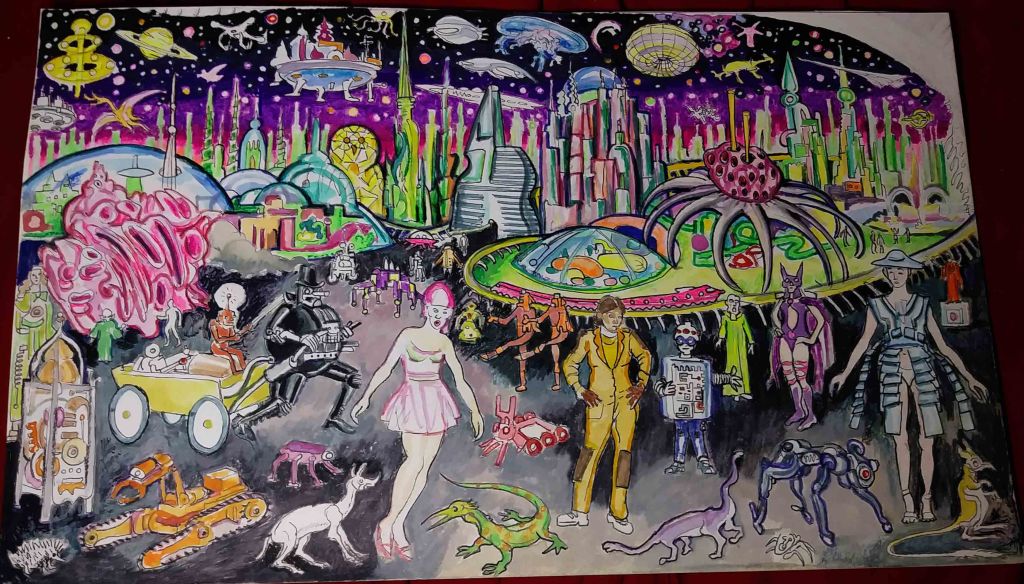You are currently browsing the category archive for the ‘cities’ category.

It is Good Friday. Usually Ferrebeekeeper posts a beautiful crucifixion painting from the astonishing canon of classical Christian art to celebrate this solemn holiday. These days though, it seems that Jesus is being crucified more-than-sufficiently by his own followers (whose inability to understand the great rabbi’s message of compassion or even to read his actual words has become the defining feature of contemporary Christianity). Therefore I have made my own little painting of Christ for Holy Week this year. It is not an image of Christ dying (or performing any of the various supernatural antics which are the frequent focus of Christian cult iconography). Instead I have portrayed Jesus riding a little white jenny into Jerusalem as he pores over a book.
The donkey is an underappreciated sacred animal in Judeo-Christian scripture. In the Bible, asses are mentioned more than 130 times (complete with specialized Hebrew equestrian vocabulary about color, age, use, and gender) and feature in some of the defining moments of scripture. Sampson uses the jawbone of an ass as his weapon. Balaam’s ass is one of the Bible’s three talking animals (and arguably the only one which is not a divinity in animal form). The (now extinct) wild ass was a symbol of grace and beauty. Throughout the scriptures, donkeys are always doing the hard work of ploughing, farming, irrigating, carrying, and even fighting (the Persian cavalry rides asses). Finally & most importantly (to Christians anyway; Balaamites might decide otherwise), Holy Week and the Passion begin when Jesus rides a white donkey into Jerusalem as described in Matthew (which, according to textual scholars, is the original gospel written by someone who was maybe a contemporary of Jesus). Here is the relevant text from the King James Bible:
21 And when they drew nigh unto Jerusalem, and were come to Bethphage, unto the mount of Olives, then sent Jesus two disciples,
2 Saying unto them, Go into the village over against you, and straightway ye shall find an ass tied, and a colt with her: loose them, and bring them unto me.
3 And if any man say ought unto you, ye shall say, The Lord hath need of them; and straightway he will send them.
4 All this was done, that it might be fulfilled which was spoken by the prophet, saying,
5 Tell ye the daughter of Sion, Behold, thy King cometh unto thee, meek, and sitting upon an ass, and a colt the foal of an ass.
6 And the disciples went, and did as Jesus commanded them,
7 And brought the ass, and the colt, and put on them their clothes, and they set him thereon.
8 And a very great multitude spread their garments in the way; others cut down branches from the trees, and strawed them in the way.
9 And the multitudes that went before, and that followed, cried, saying, Hosanna to the son of David: Blessed is he that cometh in the name of the Lord; Hosanna in the highest.
10 And when he was come into Jerusalem, all the city was moved, saying, Who is this?
11 And the multitude said, This is Jesus the prophet of Nazareth of Galilee.
12 And Jesus went into the temple of God, and cast out all them that sold and bought in the temple, and overthrew the tables of the moneychangers, and the seats of them that sold doves,
13 And said unto them, It is written, My house shall be called the house of prayer; but ye have made it a den of thieves.
14 And the blind and the lame came to him in the temple; and he healed them.
15 And when the chief priests and scribes saw the wonderful things that he did, and the children crying in the temple, and saying, Hosanna to the son of David; they were sore displeased,
16 And said unto him, Hearest thou what these say? And Jesus saith unto them, Yea; have ye never read, Out of the mouth of babes and sucklings thou hast perfected praise?
Although Jesus was putatively crucified by the Romans for pretending to the throne of Judea, careful readers will note that his death was mainly orchestrated by the Pharisees for interfering with their money-making operations (events set forth in this very passage we just read!).
The Jesus in my little painting seems to be steeling himself for harrowing the temple by checking out some relevant passages in his own sacred book (his writer’s proof copy of the Bible looks suspiciously like the same little white Bible my parents have had forever). The excesses of his followers as they throw fronds everywhere do not seem particularly connected to the son of man as he rides to the temple and to his doom (careful readers of Matthew might also be struck by how fickle, mutable, and downright frightening the multitudes can be in the story of Christ).

Of course, if this doesn’t appeal to you and you are taken back by my somewhat leading prose (and somewhat abstract image of Jesus) there is another possible interpretation of this Palm Sunday painting. The whole painting is only the size of my palm since I painted it in the tiny sketchbook which I carry with me. Sacred images and scriptural passages can have multiple interpretations, some of which are more right than others. Maybe it’s worth carefully looking at the actual book itself (without someone telling you what to think) just like Jesus is doing here!

Spring is starting to spring everywhere (even if January and February of 2024 were astonishingly mild in New York, it was still, ya know, winter) and, as April and May approach, a whole bunch of flower and bloom posts are in the offing here at Ferrebeekeeper! Thank goodness! Sometimes it is necessary to take a break from the broken realms of politics and culture to go outside and appreciate the greenery. Pursuant to which, today we have an uplifting post about an amazing plan by SUGi (an organization which supports urban forests) to plant a pocket forest here in New York City. This may seems like a post about a small native garden, but I believe the micro-forest is much larger and more important than its name might initially suggest.
The “Manhattan Healing Forest” is scheduled to be constructed/planted on Roosevelt Island in April. For non-New Yorkers, Roosevelt Island is a 150 acre island in the East River which was used throughout the 19th century as a forbidden institutional island of hospitals, prisons, and sanitariums, but which is now a more conventional residential community (even though it is only arms-length from the dense skyscrapers of Midtown). The forest will consist of more than a thousand native plants carefully arranged in accordance with the the renowned “Miyawaki Method” (named for the Japanese botanist Akira Miyawaki) which focuses on sustainability, ecological mutualism, and native planting. The method involves a holistic “bottom-up” planting strategy: first the land is stripped to the foundation and then an entire humus layer of compost and mulch is installed all at once. Upon this rich mulch, native trees, shrubs, and wildflowers are planted close together at the same time–which fosters rapid growth (since the native plants grow in symbiosis with each other and with the local insects, fungi, actinomycetes, and other lifeforms). Thanks to mutualism (and the benefits of being in the proper ecological niche) Miyawaki-style forests can reach full maturity in mere decades.

As you can see in the thrilling aerial photo above, the forest will indeed be tiny (there is the footprint, outlined in bold white). At 250 square meters (2700 square feet) it is only the size of a small back yard. However the effects of these little wildlife refuges are bigger than their square footage: such miniature wildernesses provide an opportunity for birds, insects and other animals to maintain a footprint even in the densest city. Humans benefit as well: the rooted greenery help prevent erosion and soak up rainfall while capturing carbon and otherwise filtering the air (in addition to providing a respite from hectic city life for locals). According to SUGi’s founder, some of the 40 species of flora planned for the Manhattan forest “include white oak, Virginia strawberry, butternut, New York fern and eastern white pine” .
The SUGi micro forest is designed to anchor the roots of the island against extreme weather and to provide a place of tranquil refuge to thoughtful humans However, more importantly, it is part of a hidden worldwide archipelago of ecological refugia across the world. SUGi’s little native growth forests compliment the wilderness areas, cemeteries, parks, gardens, yards, and even vacant lots which are part of the urban landscape. By stitching together these tiny safe spaces, living things can maintain a toehold in what first seems to be a wasteland of concrete, glass, and asphalt.

Humans are the architects of the urban world–we could build our cities into glorious wonderlands of self-reinforcing life. Yet generally the rancid developers, cruel traffic engineers (who hate all living things with boundless antipathy), & crooked politicians who hog the blueprints of urban planning can only envision lifeless concrete worlds hostile to ecology and inimical to lifeforms other than mean bald guys in SUVs. Lately though, there is a pervasive sense that the selfish “humans-only” model of city-building is not just failing other lifeforms, it is failing humans too. Like a coconut landing on a beach after a volcano eruption, the mini-forest is a foothold for disrupted ecosystems to reestablish itself.
Throughout the decades I have lived in New York City, I think I have been to Roosevelt Island once (when I got off the subway at the wrong stop by accident). Maybe it is time to head out there again and see the city from a new standpoint (both literally and ecologically).

Happy Mardi Gras! Sadly New York barely experiences the joyous carnival excess of Fat Tuesday (it is but one of the many tenuous pseudo-holidays of the grim gray month of February), however we did get an actual winter Nor’easter with real snow (I don’t think it has properly snowed since back before I started my blogging sabbatical!)
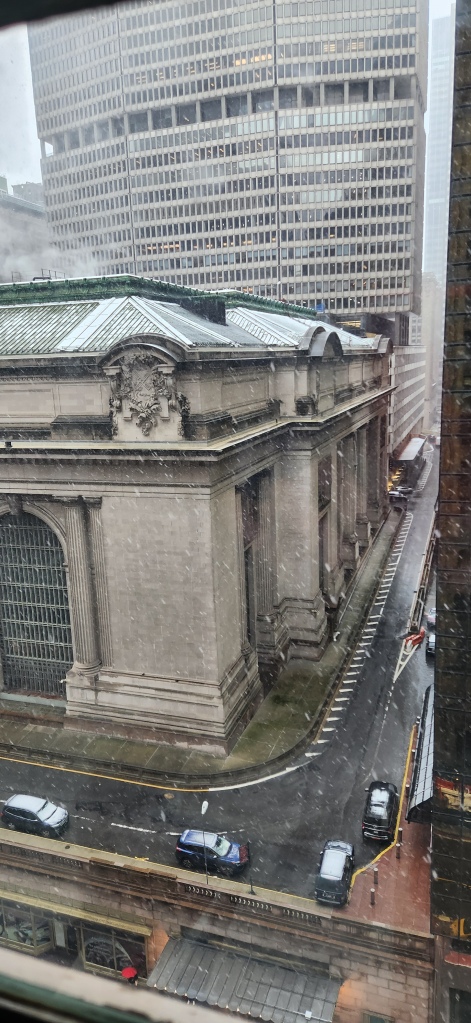
Therefore we are celebrating Mardi Gras and the winter weather with a few pictures of Manhattan and Brooklyn in their winter finery. For example, here (just above this paragraph) is a big slushy Grand Central Station with the MetLife building hulking behind it!
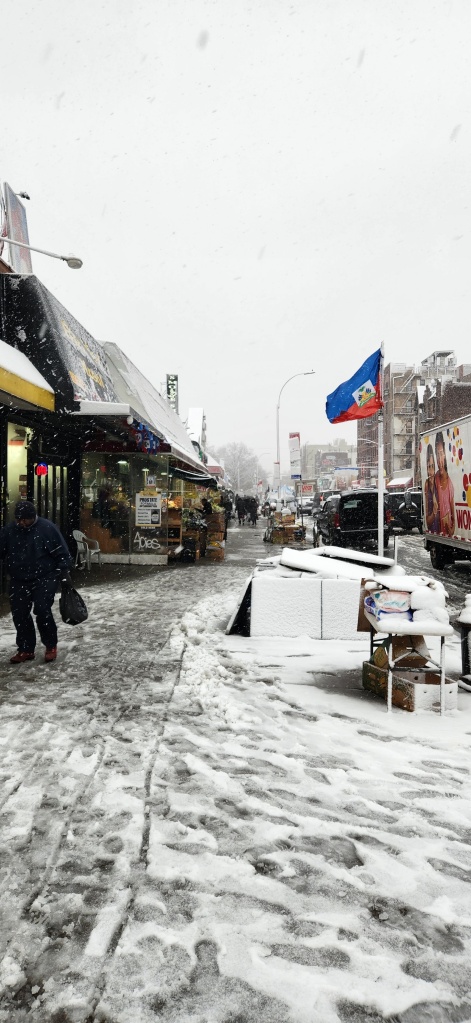
Of course these snow day pictures hardly live up to mega blizzards of the past. But the snow really is pretty and it is worth taking note of the one day of the year when everything is beautifully hidden under a monochrome coat of white (and the traffic noise is drowned out by fluffy walls of ice). photograph is the beating heart of Brooklyn’s Little Haiti neighborhood (note the cannons on that flag!) The Little Haiti part of my walk is striking in the snow because 364 days of the year, this neighborhood looks like a street in Port au Prince or something (with vendors selling tropical fruit & used shoes, cooks grilling chicken on open flame, and a wall of U.S. and Haiti flags fluttering in the sea breeze). Only on the rare snow day is it incontrovertibly revealed to be a city in the northeast.
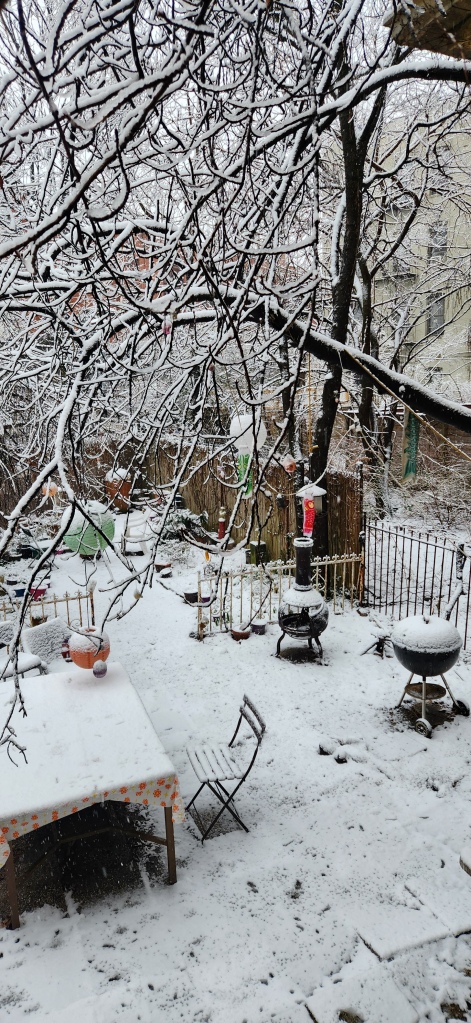
Finally here is the back yard with the gorgeous cherry slumbering beneath a coat of white (that tree changes color a lot). I wonder how long it will be before we get another snow storm. They are getting more and more scarce as the world’s atmosphere change, although, since I still have to get around town in the slush, maybe I will worry about it more in summer.


Happy Halloween! As a special inktober treat for the special day, here is another little allegorical ink drawing of our times featuring strange orchid bishops sheltering in their Romanesque monasteries. The churchmen (who do not seem especially holy or worthwhile) interact with their doomed milieu through their little handheld personal communication devices. Meanwhile the haunted world outside is subject to dragon attack, volcanic eruption, war, and doom.
As ever, the strip of nature in the foreground is the true key to the meaning of the composition.

All of this talk about Mirabilis, the fictional future city of marvels which is dying from within (the setting of Daniel Claymore’s new science fiction/mystery novel) has gotten Ferrebeekeeper thinking about arcologies. At present, an arcology is only a concept for the future–a super dense human city engineered to contain a self-sustaining ecology. However, for a long time, architects, futurists, and urban planners have been working on buildings and communities which partake of the grand ideas behind arcologies. Maybe that idea—building a mutualistic gestalt between lots of people, all their stuff, and humankind’s favorite living things—is really at the heart of urbanism.
We will talk about the implications of arcologies a lot more in the future. To my eyes, the synthesis of ecology, evolution, and engineering has only happened in rudimentary ways thus far, but humankind will need a much greater grasp of this technology (and whatever sciences lie beneath the catchall field of ecology) to proceed any farther down the road we wish to be on. For today’s post, however, we are only going to talk about contemporary news—since one of the world’s richest states has broken ground to build what is pretty definitively an arcology. The planned city will consist of two 500 meter (1640 foot) tall glass skyscrapers standing 200 meters apart (from the outer wall of one to the outer wall of the other). Between the two buildings will be an internal courtyard filled with delights. Oh yeah, I forgot to mention this–the buildings’ length will be 170 kilometers (110 miles).

This complex is part of “Neom” a strange futuristic city which will be built in the desert beside the Red Sea. The particular linear arcology/double skyscraper is named ذا لاين (which, appropriately means “The Line” in Arabic). The whole community is being planned and financed by that great utopian visionary entity–the Kingdom of Saudi Arabia!??? Sorry about those extra quotation marks, but if you were around in the late twentieth century/early twenty first century, you might be more likely to think of Saudi Arabia as an ossified petrostate more famous for a Faustian bargain between kleptocrats and Wahabi religious extremists than for futurist thinking (although, come to think of it, the Sauds arguably did have a major hand in engineering our current dystopia of global warming, religious extremism, and vast inequality).

Anyway, setting aside all political and ethical concerns, the plans for the Line were announced on January 10, 2021 by that notorious cut-up, Saudi Crown Prince Mohammed bin Salman (a fiend–er–friend to a cross-section of journalists). When it is finished, “The Line” is expected to have nine million residents (a million more people than New York City). The Line will be powered entirely by renewable energy, and inhabitants will be able to walk anywhere they want within 5 minutes. If their, uh…in-Line, destination is not 5 minutes away, they will be able to take a subterranean bullet train to any place within the arcology. Deadly motor vehicles (which killed 43,000 people in the United States alone last year) will be banned!

This actually doesn’t sound half bad and I might sign up–at least if I weren’t now on record making fun of the wife-beating, murderous, & conniving (yet reform-minded) Prince Salman. Estimated costs for building The Line run between $200 billion and one trillion American dollars (which is probably less than the Second Avenue subway line ended up costing). The Saudi government estimates it will create 380,000 skilled jobs.
Futurists, political theorists, and real estate mavens debate the merits of The Line. Humorously, the last group object that it falls down somewhat when it comes to their core mantra of “location, location, location” (located, as it is, in a barren sweltering desert with no attractions or neighbors of any sort). The real estate people also assert that it is otherwise a laundry list of development cliches and problems waiting to happen. For my part though, I am uncertain but intrigued. Even with slave labor and all of the wealth of the world’s foremost petrostate, I wonder if Saudi Arabia can build this thing according to the schematics. But imagine if they did! I admire this kind of crazy out-of-the-box thinking–and I kind of like the concepts behind both Neom and The Line. Since the United States has given up entirely on thinking about the future (and since the Germans are completely practical and the Chinese think only about subjugating Asia and Africa) somebody has to think big and attempt enormous impossible projects. I have mixed feelings about the vicious autocrats who rule Saudi Arabia, but I wish them good fortune in building their audacious science-fiction city. If it doesn’t work we will know a lot more about potential problems with insane mega engineering (on someone else’s dime). And it is does work, well we can build something like it within a canyon on the moon, or the shadow line of Mercury.

Have you ever read Rossum’s Universal Robots? It is a Czech play from 1921 which introduced the word “robot” to describe a synthetic/machine person manufactured through a state-of-the-art process. Since the play anteceded the great glut of mid-twentieth century sci-fi/fantasy novels and movies, it does not partake of their familiar narratives of futurism and high adventure, but rather is a brooding meditation on class, alienation, industrialization, and the post-human world. Rossum’s Universal Robots treats its subject with the solemn dark intensity which Mary Shelley and Kafka brought to these same questions about what it means to be human and to try to pass one’s fundamental values on to one’s offspring.
I am not asking this question out of idle curiosity (although I am curious if anyone read RUR), but rather as a means for reintroducing our old friend–and occasional guest blogger–Daniel Claymore. Claymore, an LA-based writer & director, has just published Requiem for a Good Machine, his own science-fiction work about robots replacing humankind. In Claymore’s sparkling yet chilly future megalopolis, Mirabilis, wise robot masters have built and maintain a perfect paradise habitat for humankind…because natural humans are failing and going extinct. Some unknown pathology has sapped organic people of their well-known drive to multiply and gobble up all available resources. The sad spectacle of hauntingly familiar near-future humans barely stumbling through the forms in a world which has lost its purpose makes up the backdrop of Claymore’s series. But don’t worry, this isn’t Rossum’s Universal Robots and humankind isn’t quite out of the game yet…the protagonist, Leo Song, is a classic gumshoe who will do whatever it takes to get to the bottom of a mystery. And there are mysteries aplenty in Claymore’s novel.

As a human cop in a world where robots solve 99% of all crimes within instants (and make up all the top echelons on the police force—and every other authority-wielding body), Song has his work cut out for him trying to unravel a string of gruesome murders which the robots have not solved. Also, even if the robot masters do not know who or what is committing these ghastly crimes, they certainly know a lot of things which they aren’t telling Officer Song.
Like a Dashiell Hammett sleuth, Song must bend all the rules and take terrifying risks to figure out what is going on (his sad oxygen gun is painful but not-very-effective to humans and does nothing at all to robots). Pursuing this case will take him to the inner sanctum of artificial intelligence, and out to the gritty edges of Mirabilis where the robots haven’t applied any glitter (and where non-conformist humans and trans-humans still have their own agendas).

The most compelling part of Claymore’s work deals with the robots themselves. At first these characters seem like utterly inhuman constructs of tubes, wires, and abstract shapes. Yet as we get to know them through Song’s eyes, their humanity starts to become apparent to us (in both good ways and bad). Likewise, the question of who ripped apart an expectant young mother starts to seem like a subset of the larger questions about what is going on behind the scenes in Mirabilis and how humankind and the robots have gotten to this place to begin with.

Claymore’s work is a taut thriller which will delight all lovers of action and mystery. However, the deeper roots of this work tunnel down into flintier bedrock. The dark lights of Mirabilis reflect today’s world of climate crisis, political stalemate, and ever-quickening waves of future shock. Above all else, the characters’ anomie, loneliness, and meaningless “make-work” jobs reflect the recent pandemic and the pointless nature of our empty economy.
If Karel Čapek stepped out of 1921 into today, he would not recognize anything, yet he would recognize everything. The same human drives and industrial alienation shape a world where technology grows tantalizingly close to consciousness. Daniel Claymore has reached into this morass and pulled out a glistening, squirming mass of naked wires and raw emotions which he throws in your face. You’re going to love Requiem for a Good Machine, but even if you don’t, the algorithms will think you did!
Remember Ferrebeekeeper’s erstwhile roommate Jennifer? During the beginning of the pandemic she packed up her New York City life and moved off to Knoxville. With her went her youthful ward, Miloš Cat, a dashing orphaned street-tabby whom Jennifer plucked from the mean streets of East Flatbush. Living in a dinky backwater city sounds like a bit of a mixed bag–with a handful of positive aspects of urban living balanced against a lot of missing things. And there are elements of the country too! One thing I keep hearing about is the sheer mortality of little water snakes in Jennifer’s Knoxville domicile. Apparently Miloš Cat has taken a shine to the native fauna and sucks these poor guys up like spaghetti (you know, if you ate half of spaghetti and left the mutilated remaining portion on Jennifer’s pristine floor or pillow) [Editor’s note: Please DO NOT DO THIS with snakes or spaghetti].

Anyway, what does the story of a tabby cat eating snakes in the American South have to do with today’s post? A lot it turns out! Back at the dawn of Ferrebeekeeper, we wrote about the influx of predatory Burmese pythons which irresponsible exotic snake owners dumped in the Florida Everglades. The snakes, which grow to unnerving immensity, are apex predators of Southeast Asia (surely one of Earth’s most competitive ecosystems) and they have been wreaking havoc on the ‘glades. Florida winters have not diminished the invasive snake’s numbers and even teams of armed Florida men authorized to hunt the monsters with all of the firepower available from America’s finest gun shops have done little to stop the pythons. Apparently nothing can stand against the mighty serpents.
Or so it seemed…

Floridian biologists wanted to understand more about the pythons’ nesting behaviors so they set up a camouflaged camera to observe the nest of a 55 kilogram (120 pound) laying snake. What the camera revealed was a complete shock (sorry for the clickbait sentence here in paragraph 3). A feisty swamp bobcat showed up and harassed the mama snake on her nest. Later on, when she slithered off to do python errands (eating native wildlife I guess?), the cat returned and ate all the eggs! It was a real shock to the biologists who did not expect the native swamp denizens to stand up to the Burmese python so effectively. They are setting up a new snake camera elsewhere, however, at least a certain furry someone seems to have the python’s number. Biologists will now keep their eyes open to see whether other bobcats are wrecking snake nests and eating python eggs throughout south Florida (and how much of an impact this has on the snakes). Hopefully Miloš will take this lesson to heart too, and stop eating up the native fauna of Tennessee (lest some Appalachia hill snake strike back at the non-native).

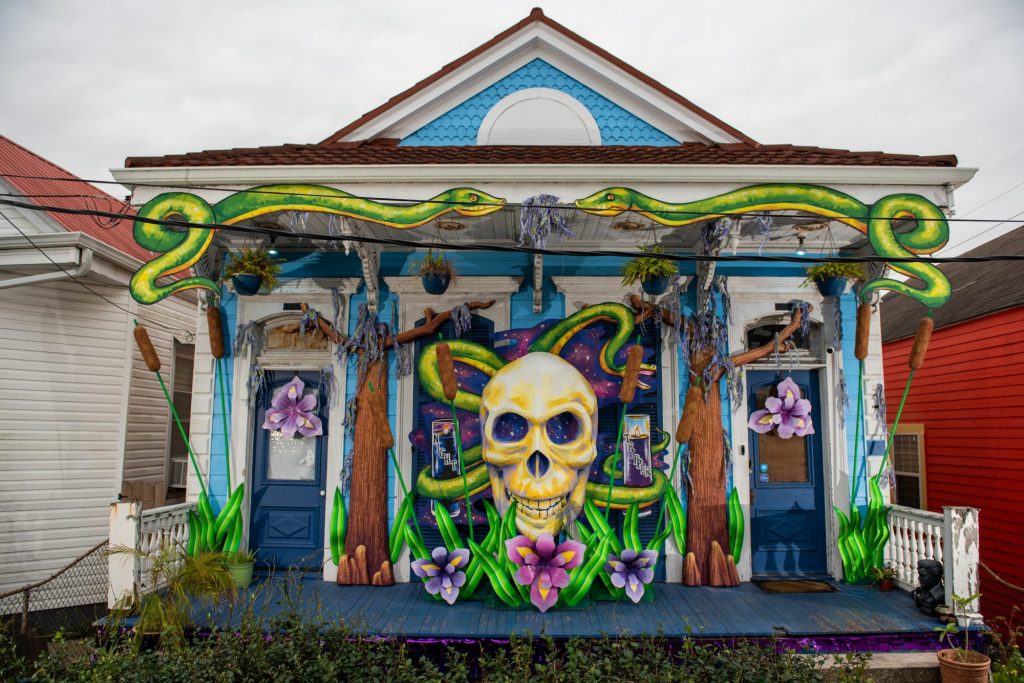
Happy Mardi Gras! Tonight at midnight, the Lenten season of austerity begins. Today is therefor a holiday of merriment and excess in Catholic parts of the world. The most famous Mardi Gras celebration in the United States is, of course, the great Mardi Gras parade in New Orleans, finally returned to full glory this year after two long years of plague and quarantine. During the corona years, however, New Orleans natives (and members of the illustrious parade krewes which put the spectacle together) did not entirely give up! They decorated certain key houses around the Big Easy in the same manner as parade floats. For tonight’s carnival delectation, here is a little gallery of some of those lovely cottages wearing their mad finery:
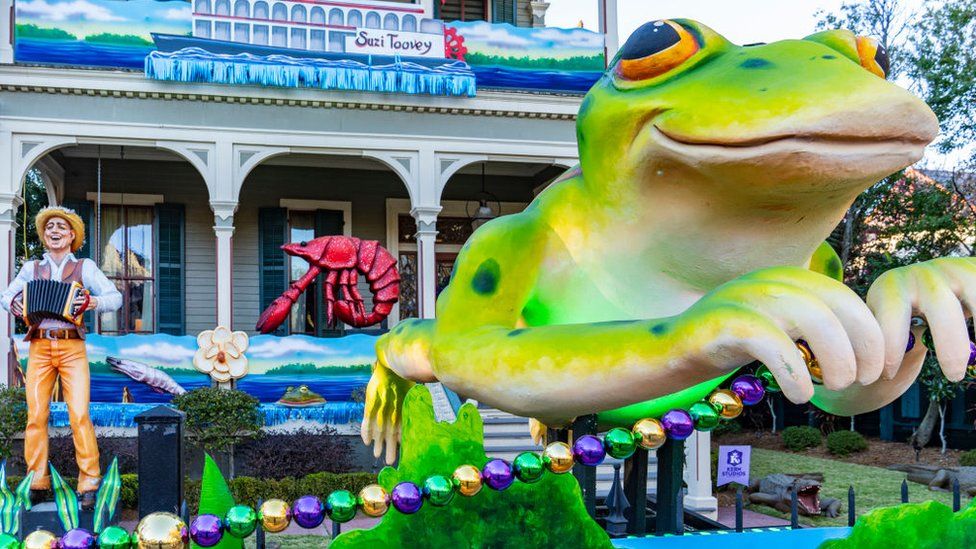
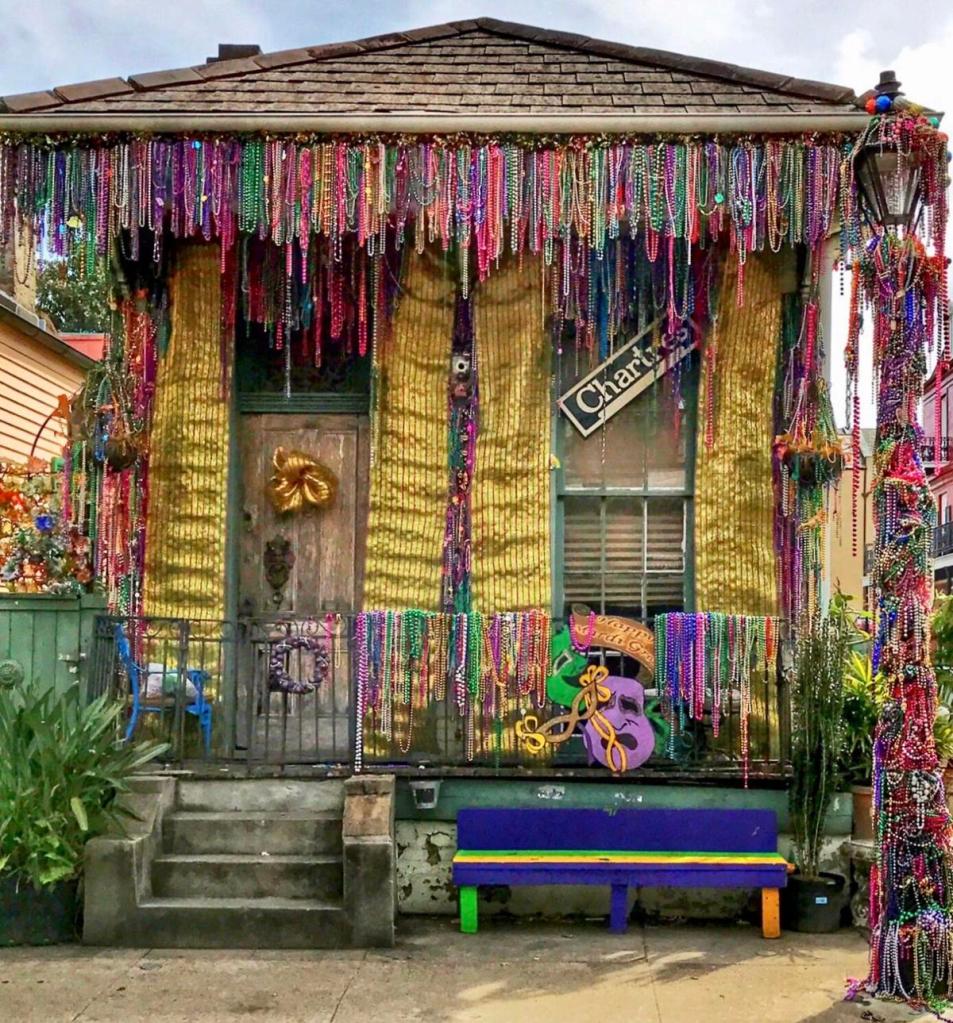

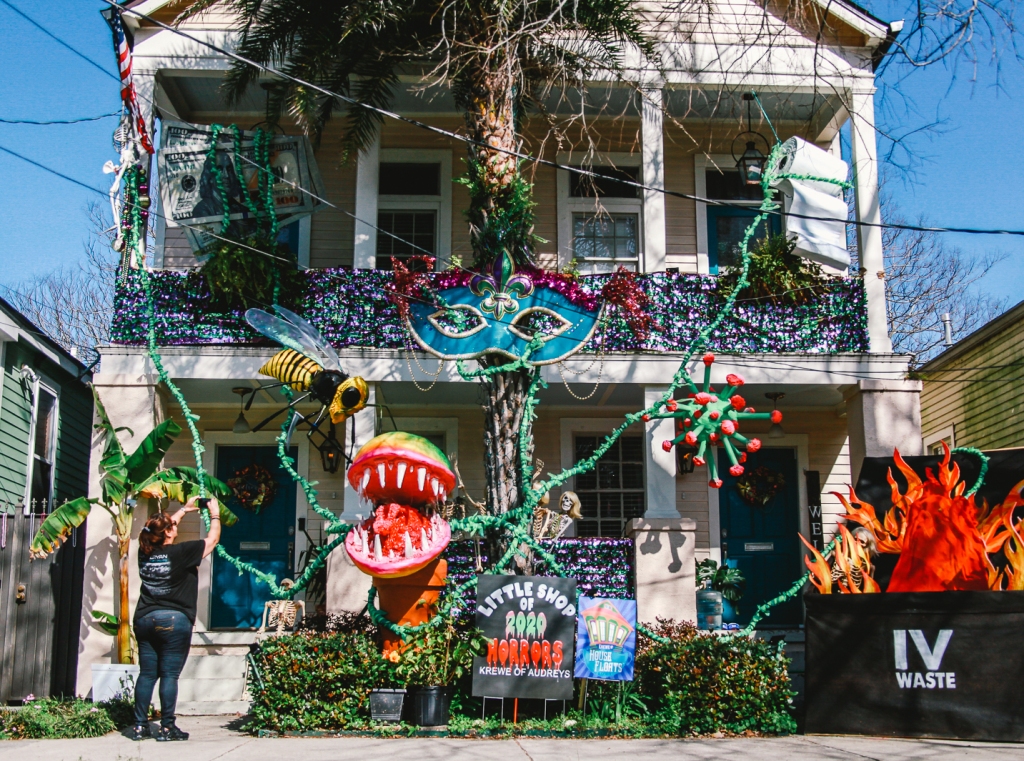
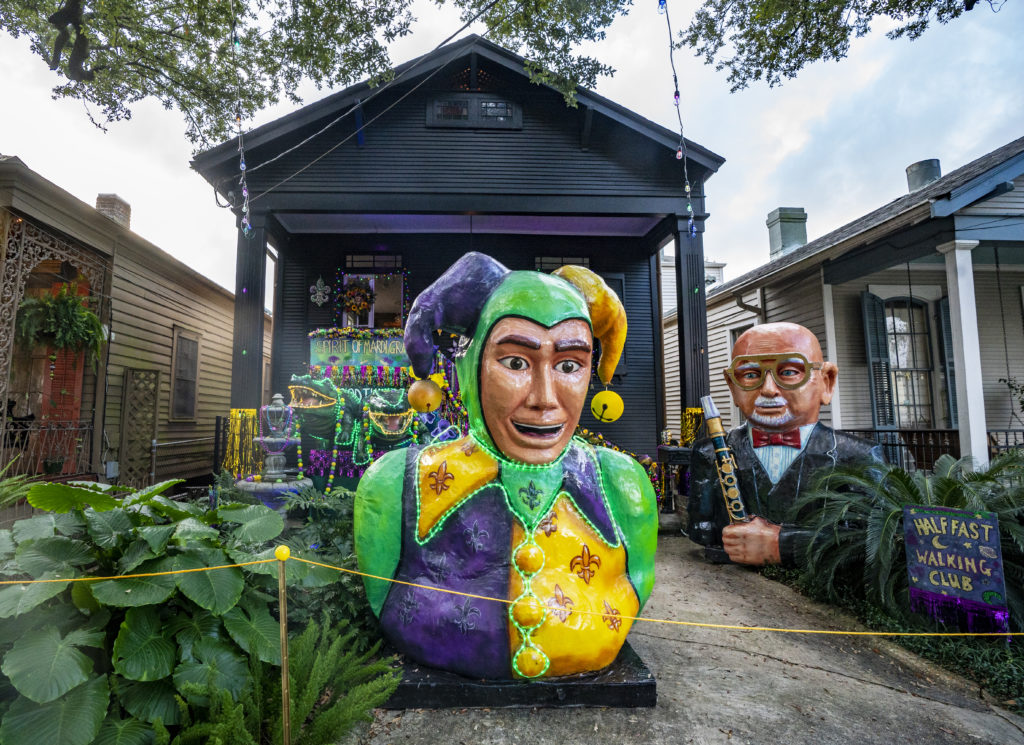
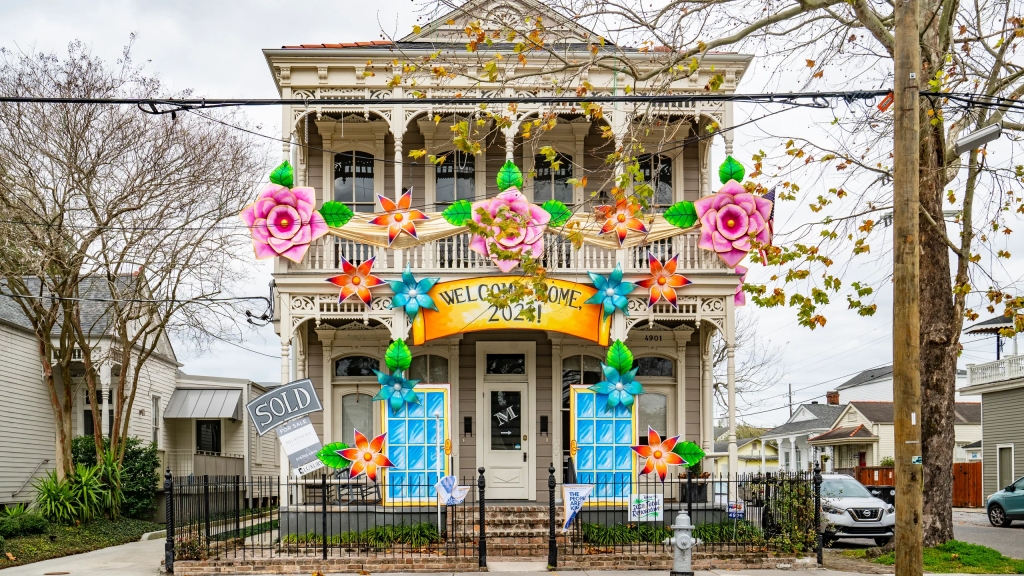

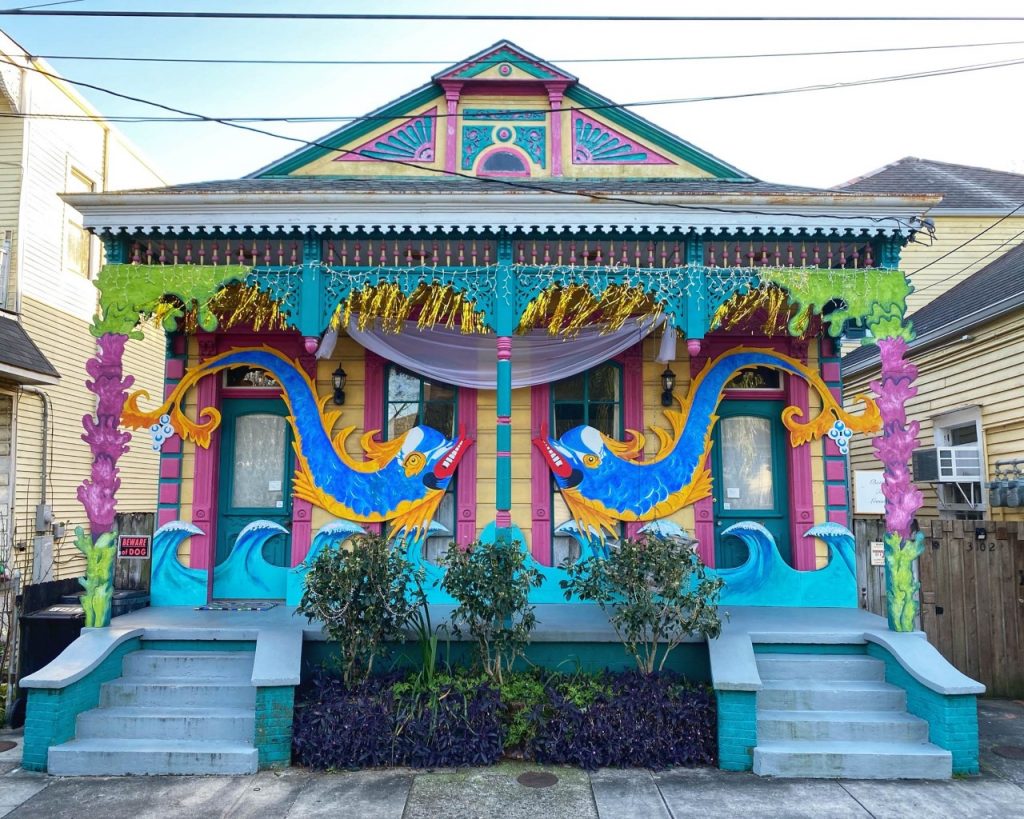

Laissez les bons temps rouler!





